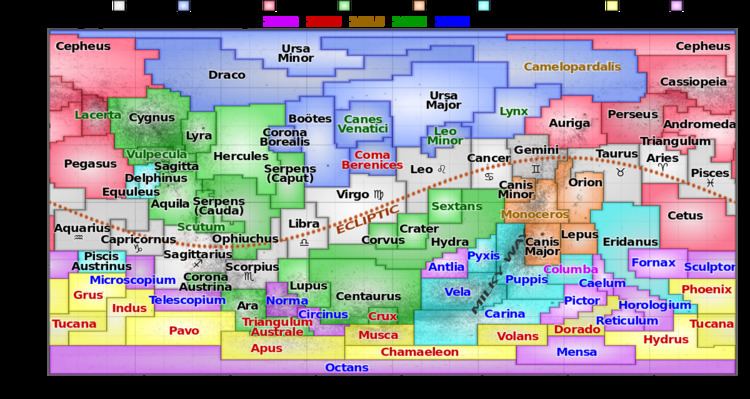 | ||
In modern astronomy, the sky (celestial sphere) is divided into 88 regions called constellations, generally based on the asterisms (which are also called "constellations") of Greek and Roman mythology. Those along the ecliptic are the constellations of the zodiac.
Contents
The ancient Sumerians, and later the Greeks (as recorded by Ptolemy), established most of the northern constellations in international use today. When explorers mapped the stars of the southern skies, European and American astronomers proposed new constellations for that region, as well as ones to fill gaps between the traditional constellations. Not all of these proposals caught on, but in 1922, the International Astronomical Union (IAU) adopted the modern list of 88 constellations. After this, Eugène Joseph Delporte drew up precise boundaries for each constellation, so that every point in the sky belonged to exactly one constellation.
History
Some constellations are no longer recognized by the International Astronomical Union, but may appear in older star charts and other references. Most notable is Argo Navis, which was one of Ptolemy's original 48 constellations.
Modern constellations
The 88 constellations depict 42 animals, 29 inanimate objects and 17 humans or mythological characters.
Abbreviations
Each of the IAU constellations has an official 3 letter abbreviation. They are actually abbreviations of the genitive form of the constellation names, so some letters appearing in the abbreviation may come from the genitive form without appearing in the base name (as in Sge for Sagitta/Sagittae, to avoid confusion with Sagittarius, abbreviated Sgr).
The majority of the abbreviations are just the first three letters of the constellation, with the first character capitalised: Ori for Orion, Ara for Ara/Arae, Com for Coma Berenices. In cases where this would not unambiguously identify the constellation, or where the name and its genitive differ in the first three letters, other letters beyond the initial three are used: Aps for Apus/Apodis, CrA for Corona Australis, CrB for Corona Borealis, Crv for Corvus. (Crater is abbreviated Crt to prevent confusion with CrA.)
When letters are taken from the second word of a two-word name, the first letter from the second word is capitalised: CMa for Canis Major, CMi for Canis Minor.
The abbreviations are unambiguous, with two exceptions. Leo for the constellation Leo could be mistaken for Leo Minor (abbreviated LMi), and Tri for Triangulum could be mistaken for Triangulum Australe (abbreviated TrA).
List
For help with the literary English pronunciations, see the pronunciation key. There is considerable diversity in how Latinate names are pronounced in English. For traditions closer to the original, see Latin spelling and pronunciation.
The "Family" column refers to the constellation families introduced by Donald Menzel in 1975.
Asterisms
Various other unofficial patterns have existed alongside the constellations. These are known as "asterisms." Examples include the Big Dipper/Plough and the Northern Cross. Some ancient asterisms, for example Coma Berenices, Serpens, and portions of Argo Navis, are now officially constellations.
